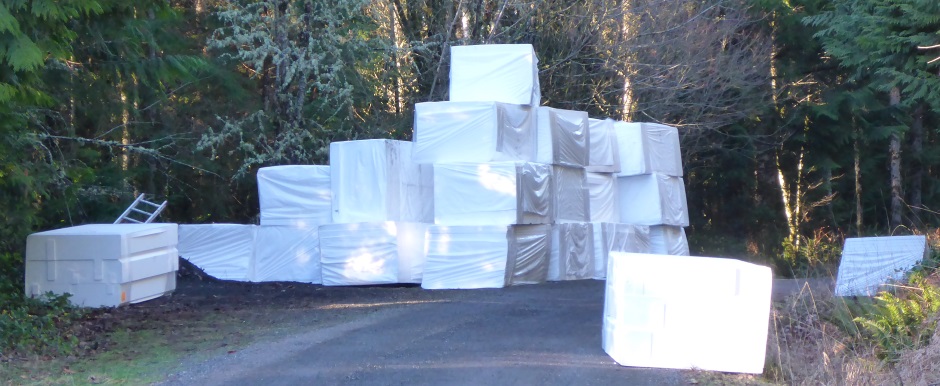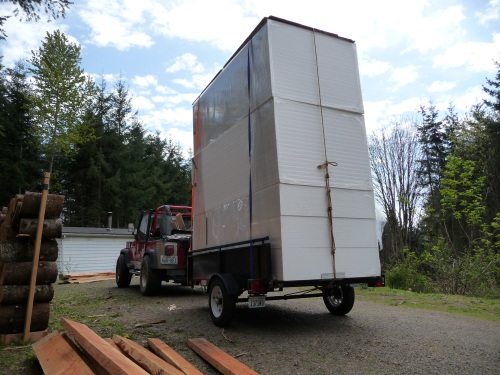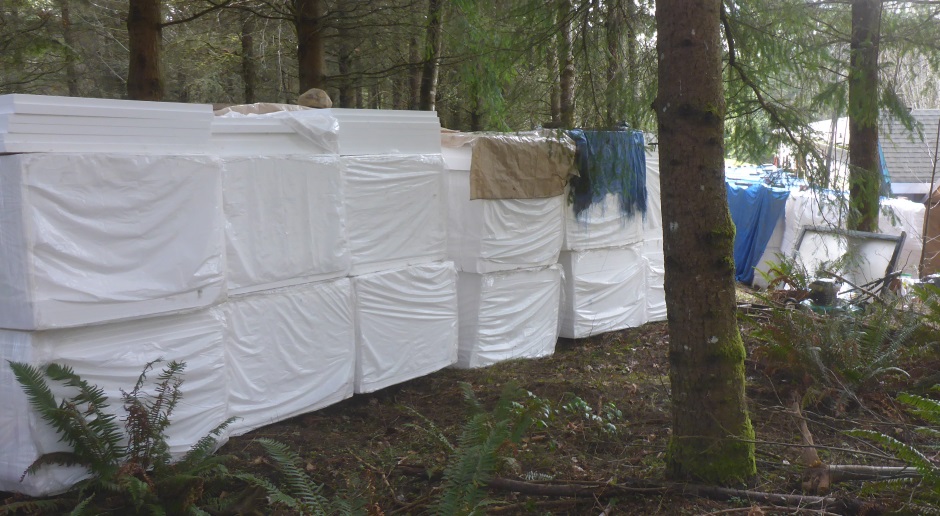Expanded Polystyrene Sheet
What is EPS?
Expanded Polystyrene is actually 98% air. Only 2% is actually polystyrene. It is the air that provides the insulation and the job of the polystyrene is to keep the air very still so that hardly any convection occurs. EPS is chemically inert and will not decay, decompose, or produce bad gases or leachates to the surrounding environment. It contains no CFCs, HFC's, HCFC's , dyes, or formaldehyde. It will not contaminate ground water and it is deemed safe enough to make coffee cups. It is not a food source for animals, insects, ants, or termites, and it will not mold. It does give off nasty fumes when burnt, but all EPS for building has fire retardant added. The fire retardant chemical added is actually the worst ingredient of EPS, but it is required by building code. EPS can be recycled by grinding it up and adding the "regrind" back into the mix. In practice most sheets of EPS have some percentage of regrind.
Why EPS rather than XPS
XPS gives off gasses and is more expensive
Expanded Polystyrene (EPS) is my preferred insulation material. I prefer it over Extruded Polystyrene (XPS) because XPS gives off noxious gasses for about 10 years after manufacture. EPS has an R value (insulation value) of a bit over 4 per inch (R-4). XPS is often quoted as R-5 per inch (ie a better insulator) but after 10 years the gas will have leaked out and it will be down to closer to R-4 per inch. EPS is lower cost than XPS.
EPS Specs
These specs have been compiled by averaging out the different manufacturer specs and other sources.
| Type | PSI (10%) | Creep psi | R/in 40F | Pounds lb/ft3 | g/cm3 |
|---|---|---|---|---|---|
| 1 (EPS15) | 9 | 3.6 | 4.17 | 1 | 0.016 |
| 2 (EPS19) | 15 | 5.8 | 4.5 | 1.5 | 0.024 |
| 9 (EPS29) | 25 | 10.9 | 4.6 | 2 | 0.032 |
| 14 (EPS39) | 40 | 15 | 4.7 | 2.5 | 0.040 |
| 15 (EPS46) | 60 | 18.6 | 4.8 | 3 | 0.048 |
When buying EPS you need to specify the load bearing density that you need. The EPS industry defines "types" rather than specifying a PSI (Pounds per Square Inch) value directly. When used in geofill applications it's called by an EPSXX name. You can get EPS up to 100psi, but there is a large price premium so really 60psi is the highest economical specification. Typically 40 and 60psi is a special order with an ingot sized minimum quantity and a couple of weeks lead time.
How it's manufactured
Vacuum chamber makes big blocks
EPS is made in a large vacuum chamber. Typically these
vacuum chambers are supplied by an Italian company and have an
associated sophisticated computer control system that controls and monitors all
the variables. Dense beads of polystyrene are introduced into the
vacuum chamber and are expanded by the vacuum and some steam. It's a bit like
making popcorn, but using a vacuum and steam. The result is a large
block of Expanded Polystyrene (EPS) that has the same dimensions as the inside of the
chamber. A typical block size is 3 feet x 4 feet x 16 feet.
Actually they tend to have an extra inch on these dimensions as the
edges are a bit rugged and are best cut off so typically the blocks
are 37" x 49" x 16'1"
Blocks are cut using CNC hot wire
Even if just making simple sheets of EPS, it is necessary to cut the blocks of EPS using a hot wire cutter. You give the computer controlled hot wire cutter the details of the profile you want (eg sheet thickness or something more complicated) and it cuts the blocks as required. Typically a CNC cutter machine only has a bed size of 8 feet, so it is necessary to start by cutting the 16 feet blocks in half. Cutting of multiple identical shapes (or of course multiple sheets) can be done by fitting the machine with multiple parallel cutting wires.
How it's priced
Mainly about the ingot cost
Depending on your supplier, there may be a small cutting charge, but primarily the price is determined by the cost of the big ingot of EPS produced in the vacuum chamber. To a first approximation, 1" thick sheets will be half the price of 2" thick sheets. A 3'x4'x8' ingot will give either 36 8'x4' sheets of 1" thick or 18 8'x4' sheets of 2", etc. If you want EPS cut with say an "amphibious landing craft" profile then again the price will primarily be determined by how many you can get from the ingot. You will be charged for any offcuts resulting from cutting some weird profile, so you may as well also take delivery of the offcuts and try to find a use for them (eg use them as ground fill or random insulation). When designing the profile you want (such as I did for the Carnation Flooring) it is worth also thinking how to end up with offcuts that are of some use.
Given that the cutting seems to be close to free, it makes sense to for example have twice the number of 2" sheets rather than using 4" sheets because this allows the sheets to be staggered to avoid seams. Having said that, you do need to consider the cost of foam adhesive to glue them together.
Density is a big determiner of ingot price
Here is the rule of thumb that I use to figure out the price differential between different densities. It shows how much more expensive the different types (densities) are relative to regular Type 1 EPS.
Type 1 (9 psi)
1x
Type 2 (15psi) 1.4x
Type 9 (25psi) 1.6x
Type 14 (40psi) 2.3x
Type 15 (60psi) 2.75x
EPS compression under weight load
PSI calculation
In my case I am using EPS even under the footings. The entire house is built on polystyrene. The EPS is taking the entire weight of the house and the house weighs something like 750 tons (in the USA a ton is 2000 pounds). EPS can take a lot of weight as long as there is something above to smoothly distribute the weight. The concrete above is the weight distributor, so everything works fine. All that it is necessary to do is calculate the weight of the house (in pounds) and then divide that by the number of square inches of footing. As long as this figure is comfortably within the "Creep PSI" figure for the EPS then everything is fine.
The creep issue
The PSI rating for the EPS describes the load for the EPS to compress by either 5% or 10% (depending on the manufacturer), but this is only half the story because if you leave that load on for a long period of time there will be further compression. This long term additional compression is called creep. Creep is time dependent deformation when the EPS is subjected to a constant load.
To avoid creep you need to keep the loading to within the elastic portion of the load/compression curve for EPS. The elastic portion of the curve is given by the "compressive modulus" (aka "elastic modulus") spec figure for the EPS. A typical "compressive modulus" for 40 psi EPS is 1500 psi. You need to keep within 1% of this figure to avoid creep. In other words for 40 psi EPS you can have 15 psi max applied for 1% deformation to avoid creep.
The following gives the approximate compressive modulus and maximum loading for the different EPS types:
Type 1, 10 psi (EPS15)
360 3.6 psi
Type 2, 15psi (EPS19)
580 5.8 psi
Type 9, 25psi (EPS29)
1090 10.9 psi
Type 14, 40psi (EPS39)
1500 15 psi
Type 15, 50psi (EPS46) 1860 18.6 psi
Note that there is no catastrophic failure mode. Even if you were to overload the EPS beyond the creep load and even the rated PSI figure then all that would happen is that the house would just sink down uniformly by an inch or so and you would have slightly less insulation R factor under your footings.
(Thanks to Stefano Antonelli and Jim Whalen from Plasti-Fab for providing me info on the creep issue. There is also a good article at http://www.softoria.com/institute/geofoam/material.html#35 that Stefano pointed me to.)
EPS water permeability
EPS breathes better than XPS
EPS is less waterproof than XPS, but only because XPS typically comes with a thin polyethylene film bonded on each side. In wall design it is actually rather important that walls can dry out so it is actually a benefit that EPS is "less waterproof" because it does allow some water vapor to permeate through to dry the inner wall.
EPS is 3 perms for an inch thickness. So 3" thick EPS is 1 perm, and half an inch of EPS has a perm value of 6.
Termite resistance
Additive treatments are of limited value
It is possible to request that the EPS be manufactured with a termite resisting compound added to the mix. AFM Corporation's PerformGuard (or equivalent) is added to the EPS mix during the expansion process.
http://performguard.com/performguard-solution.asp
http://afmcorporation.com/
Sometimes it's called Borate-treated.
Opinions vary as to whether termite treatment actually works. I decided not to bother with it as I am not in a high termite area and I have lots of sheets of 6 mil polyethylene to protect the EPS.
Storing EPS
Try to keep it out of the sun
EPS is attacked by UV rays and after a few months in the sunshine it will develop yellow dust on its surface. It's not a big deal as the dust brushes off, but it is still best avoided. In my case I store the EPS in my forest area so that it is sheltered from the sun by the tree cover.
Gluing EPS
It burns
You cannot use regular glue such as PL-Premium construction adhesive on polystyrene because it will burn through it (ie melt it). The correct glue for polystyrene is here .
Cutting EPS
For cutting lots of EPS to a particular width it is best to make yourself a hotwire cutter bench. For random lengths then use a thin long craft knife.
EPS suppliers
Need a fairly local supplier
You will want to find a fairly local manufacturer of EPS or else the shipping cost will be exorbitant (due to the volume rather than the weight).

I have three fairly local suppliers:
Northwest Foam Products, Inc in Twin Falls Idaho
FMI-EPS in Post Falls Idaho
Insulfoam in the south Seattle area.
The products from the companies are essentially equivalent. They all have the ability to hot wire cut to a profile in a supplied drawing.

Northwest Foam Products, Inc
2390 Rostron Circle Twin Falls, ID 83301
Ph. 208-734-7426 Fx.
208-736-8690
Mike Stireman
mike@northwestfoam.com
info@northwestfoam.com
This is my preferred supplier. Very helpful and a good price.
FMI-EPS
This is a company owned by a hands-on PhD guy.
Post Falls,
Idaho.
Steve Nelson
steve@fmi-eps.com Cell: 206-550-3110.
Insulfoam
The upside with this company is that they are very local to me (45 minute drive). The downside is that they only sell via distributors, which increases the price significantly and slows up communication. I tend to only use Insulform for small quantities that I have not properly foreseen ahead of time.
They use a large vacuum chamber that produces 4'x4'x24' blocks.
Insulfoam Manufacturing Facility
19041 80th Avenue South
Kent, WA 98032
TF 800.775.9424
T 206.242.9424
F 425.251.8405
tblake@insulfoam.com Sales
Order via Allied
Address: 14390 NE 200th St
Woodinville, WA,
98072 Phone:
425-487-1166
http://www.alliedbuilding.com/
My choices
EPS density for footings and some slab
The highest density EPS that it is economic to buy is 40 psi (2.5 lb) and that's my design choice for under the footings and for some of the slab.
Having a higher density is nice
Even when weight carrying ability is not an issue (eg wall insulation) it is still nice to use a higher density than regular Type 1 EPS as it will be less susceptible to mechanical damage. 15 psi is a good choice. I never use Type 1 EPS.




